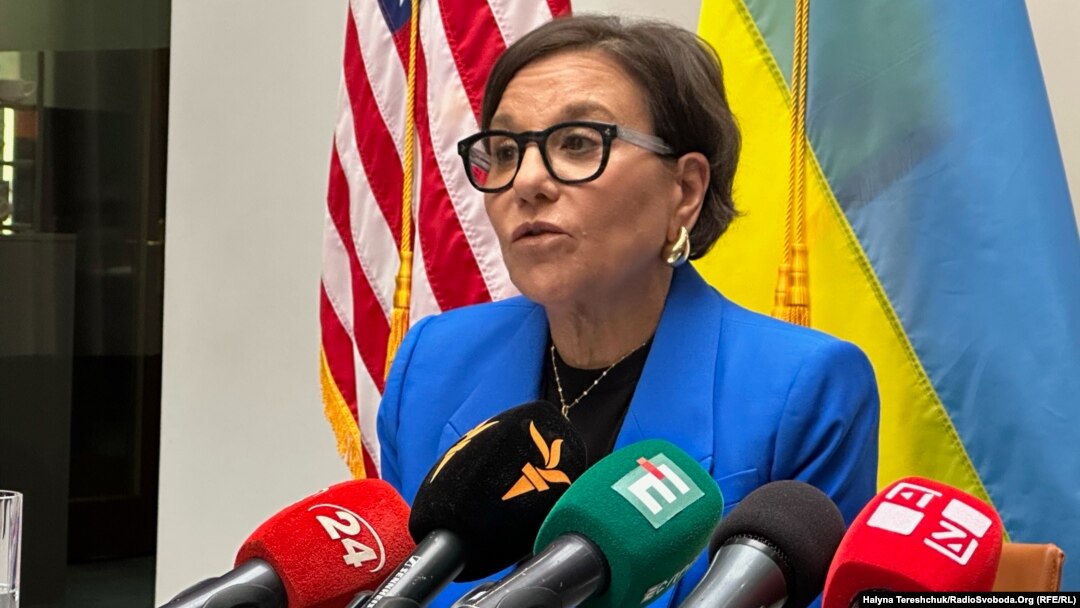WASHINGTON -- U.S. Special Representative for Ukraine's Economic Recovery Penny Pritzker on July 31 outlined a five-step plan to make Ukraine's economy more attractive to private sector investment.
"Ukraine is undertaking Europe's largest, most complex reconstruction and economic recovery ever since World War II," Pritzker said, speaking at a think tank in Washington following a visit to Kyiv on July 29.
Pritzker cited a World Bank estimate from spring of this year that Ukraine's recovery will cost at least $486 billion, but she said this came out prior to the increased fighting in March and the summer.
Pritzker said Ukraine's economy has shown resilience and growth in the midst of Russia's full-scale invasion and expressed confidence that Ukraine "has economic greatness in its bones." She noted that in 2023, Ukrainian GDP grew 5 percent and tax revenue was up 25 percent.
"We have helped the Ukrainians keep their economy going, tackle corruption, and increase private sector engagement," Pritzker said. "Through it all, we have worked with the Ukrainians to develop a long-term recovery framework -- a blueprint that I call Ukraine's Path to Prosperity."
In the long-term, Pritzker said Ukraine needs to focus on attracting foreign investment. She said the international community should be encouraged by the fact that investments have increased 17 percent in Ukraine and there were over 37,000 new businesses registered in 2023.
Pritzker said Ukraine's expansion is "proof of concept" that Ukraine's economy will succeed through the mining of critical minerals such as lithium and titanium and the development of the agricultural and defense industrial sectors.
The defense industrial sector, which Ukrainian Ambassador to the U.S. Oksana Markarova described as "an inseparable part of Ukraine's success," has experienced record growth.
Markarova, speaking at the same event, said Ukraine has increased metalworks production 27 percent, cable and fiber-optics production 101 percent, and dozens of new companies that develop drones and unmanned aerial vehicles have been founded since the war began.
"The innovation-to-battlefield time is two weeks," Pritzker said, adding that U.S. innovators should try to learn from Ukrainian ingenuity.
SEE ALSO: Suspect In Killing Of Former Ukrainian Lawmaker Denies GuiltPritzker said her plan is "ambitious but achievable" and modeled after the Marshall Plan, the U.S.-sponsored program to rebuild Europe after World War II. She described the Path to Prosperity plan as a "new economic model and social contract" that will strengthen Ukraine in the war while easing its economic future.
The first step of the plan is to develop a body that plans and prioritizes reconstruction programs into a "single-project pipeline" which Pritzker said must integrate city, municipal, and regional priorities. Pritzker called this integration the "missing link in Ukraine's reconstruction."
Next, Pritzker said Ukraine should "rapidly increase the number of shovel-ready projects" to prepare for investment and implementation.
This is followed by the continuation of reform efforts. Pritzker said Ukraine must "keep up the momentum" on new asset declaration and anti-monopoly laws. She also said Ukraine should codify the Digital Restoration Ecosystem for Accountable Management (DREAM) database platform to monitor corruption and maintain transparency.
Pritzker also said the world must marshal more funds for Ukraine.
Ukraine needs a "runway to prevail in the war" supported by the international community, but that "justice requires that the reconstruction be largely underwritten by Russia," Pritzker said.
Pritzker said the fifth and final step of her plan is that Ukrainians should return to their country to work when it is safe to do so.


